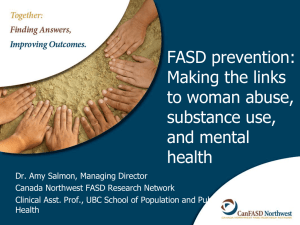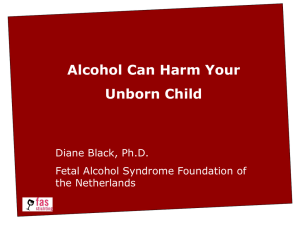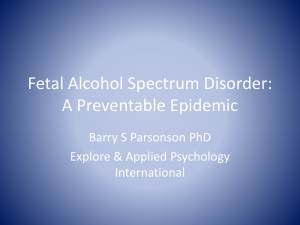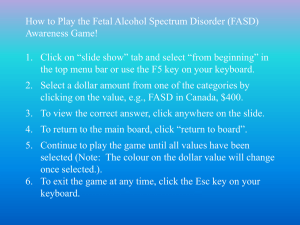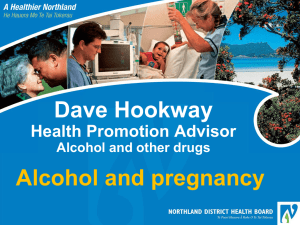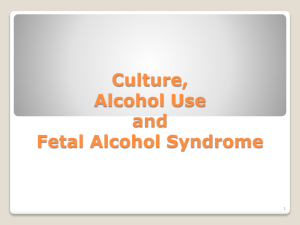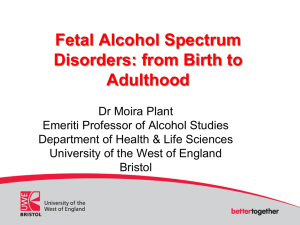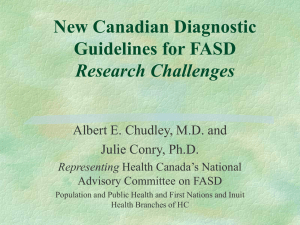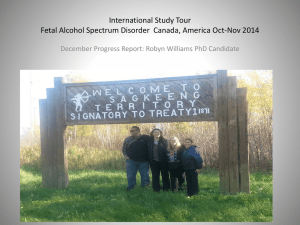Evike Goudreault presentation: Addressing the impact of prenatal
advertisement
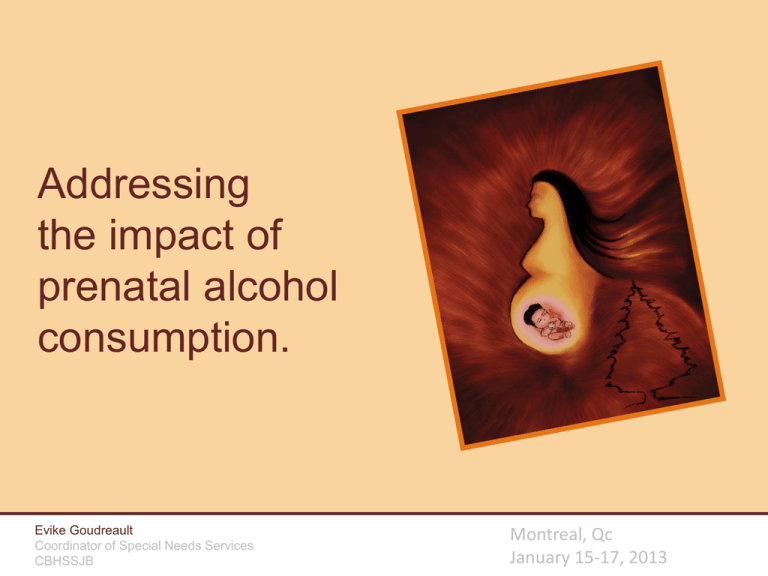
Addressing the impact of prenatal alcohol consumption. Evike Goudreault Coordinator of Special Needs Services CBHSSJB Montreal, Qc January 15-17, 2013 OBJECTIVES To understand the TERMINOLOGY and CHARACTERISTICS of FASD; To understand the factors related to the IDENTIFICATION and DIAGNOSIS of FASD; To begin to understand HOW FASD IMPACTS THE CREE NATION and what we can do. FACTS AND STATS The impact of prenatal alcohol consumption over a lifespan. Alcohol A colourless, volatile flammable liquid. It is used as a solvent, in drugs and cleaning products, explosives and intoxicating beverages. Alcohol is a “teratogen” – a substance that causes permanent birth defects. Alcohol Thiladomide vs Both are teratogenes but alcohol causes invisible disabilities. Ethanol crosses the placenta FREELY Pathway of alcohol through the mother to the fetus. Alcohol enters body through the mouth and into the stomach… …is absorbed through the intestine and enters the mother’s bloodstream… …then passes through the placenta and is carried through the umbilical cord to fetus. It finally enters the blood circulation of the fetus. “Alcohol produces serious effects in the brain of the developing child. These effects from alcohol are more serious than effects from heroin, cocaine and marijuana.” - American Institute of Medicine “FASD is considered to be the leading cause of development disabilities and mental retardation world-wide.” - Journal of FAS International 2004; Roberts and Nanson 2000 Fetal Alcohol Spectrum Disorders Prenatal Alcohol Exposure Apparently normal child FASD Death pFAS ARBD (Partial FAS) (Alcohol-related birth defects) ARND (Alcohol-related neurodevelopmental disorders) FAS ARND Alcohol-Related Neurodevelopmental Disorder Confirmed maternal alcohol exposure; Evidence of impairment in 3 or more of the following central nervous system domains: Memory Social skills Abstract reasoning Attention deficit Hyperactivity Adaptive behavior Brain structure Cognition IQ < 70 Academic achievement Communication Executive functioning Hard and soft neurologic signs The sole cause of FASD is FASD is NOT caused by Women drinking alcoholic beverages during pregnancy. Consumption of alcohol prior to pregnancy; Alcohol use after child is born; Paternal intake of alcohol. For the guys: Biological fathers cannot cause FASD But studies show that women who are with partners who drink are more likely to drink during their pregnancy. Future father’s role: Support the woman’s choice not to drink during her pregnancy. FACTORS THAT DETERMINE THE LEVEL OF DAMAGE THE DOSE OF ALCOHOL IS IMPORTANT NO amount is absolutely dangerous. NO amount is absolutely safe. MOST dangerous pattern seems to be high dose binges once or twice a week. What constitutes a drink? Each of these contains about the same amount of alcohol (.48 oz. pure alcohol) Beer can Wine glass Shot glass 12 oz. x 4% 4 oz. x 12% 1.2 oz. x 40% Timing is an important factor The first 10 days, prior to implantation, are low risk Between week 2 and week 12 is very high risk for major malformations including brain damage The last 6 months are high risk for continuing impacts on brain and on growth Critical periods in human development Week 3 Week 4 Week 5 Week 6 Week 8 Week 16 Week 38 Central nervous system Heart Upper limbs Eyes Lower limbs Teeth Palate Extended genitalia Ears = Major congenital anomalies = Functional defects & minor congenital anomalies During the 1st semester, alcohol may: Cause serious damage to the developing brain; Disrupt normal cell migration; Affect vital organs (heart, liver and kidneys); Cause facial malformations; Provoke miscarriage. During the 2nd semester, alcohol may: Affect the development of the brain; Provoke miscarriage that may put the mother’s life in danger; Damage muscles, skin, teeth, glands and bones; During the 3nd semester, alcohol may: Interrupt the development of the brain and lungs; Prevent normal weight gain; Provoke a premature birth. Factors that determine the level of damage Amount of alcohol consumed Pattern of consumption (daily vs binging) Frequency of use Timing of exposure during fetal development Fetal and maternal genetic factors General living conditions during pregnancy Mother’s tolerance for alcohol; her size, age and weight Understanding alcohol consumption during pregnancy Alcohol is a commonly used, legal and available substance not generally thought of as a powerful drug capable of causing harm to an unborn child. High numbers of pregnancies are unplanned (50-70% according to research) Mothers may be unaware of their pregnancies in the early weeks Women who consume a lot of alcohol often have irregular menstrual cycles and may not recognize the signs of pregnancy, such as nausea, as being related to their pregnancy. Male partners or friends may contribute to a pregnant mother’s drinking because they do not want to lose their drinking partner. Partner abuse = stress and may increase drinking. Fetal Alcohol Syndrome was first identified as a medical condition in 1973. “Behold, thou shalt conceive and bear a son: and now drink no wine or strong drinks.” - Judges 13:7 1500 in Europe Francis Bacon warned against using alcoholic beverages during pregnancy 1500 in Canada Before Europeans came to North America, Canada was totally bone dry and its inhabitants were abstinent. Historical references to alcohol consumption in Canada Early 1800s Alcohol is introduced in the Native economy by Northwest Company. World Health Organization (WHO) FASD is now acknowledged by the World Health Organization as the leading recognized cause of intellectual disability in the Western World. STATS Canadian stats on birth defects 4500 4000 3500 2000 1500 1000 500 0 FASD HIV Infection Spina Bifida Down Syndrome Prevalence The percentage of the population having specific disorder at a specific moment in time. Population of Canada 33,200,000 IF the prevalence of FASD = 1/100* THEN the prevalence of FASD = 332,000 *CDC “guestimate” for the United States Webinar Clarren & Loock 2011 Incidence The number of new cases of a disorder that will occur over a specific period of time. (i.e. newborns) Births in Canada (2008) 364,300 IF the incidence of FASD = .9/100* THEN the incidence of FASD = 3,279 *CDC “guestimate” for the United States Webinar Clarren & Loock 2011 Incidence/Prevalence rates in Canada Considerations Low incidence and prevalence rates could mean: Prevention is working or there is low identification of the disease Prevalence & Incidence of FASD in various populations Full FAS: 0.33 – 2 per 1000 [~1:500] Full FAS (In-school): 2 – 7 per 1000* [0.7%] Full FAS (Foster care): 10 – 15 per 1000** [1.5%] FASD: 9 per 1000 [1%] FASD (In-school): 20 – 50 per 1000 [5%] FASD (BC)*: 190 per 1000*** [19%] Every hour, two children are born brain damaged due to alcohol consumption during pregnancy *May, 2009; **Astley, 2009; ***Robinson, 1986 CAPHC FASD Update 2010 Provincial statistics Manitoba study, (Fuchs, Burnside, Marchenski, & Mudry, 2005) found 17% of children in foster care were affected by FASD. In an Ontario study involving 28,000 students, 21.4% are receiving Special Education Services, most of them because of prenatal exposure to alcohol. Cree Nation 900 80% 720 individuals (aged 0-29) identified as having special needs mothers confirmed alcohol consumption at some point during pregnancy Individuals identified as having special needs, possibly exposed to alcohol during pregnancy Under-diagnosed FASD is under-recognized and often goes undiagnosed; it is difficult to be certain how many individuals have FASD 720 exposed 3 diagnosed FASD comes with lifelong costly disabilities $1.8 million for one particular person with FAS Annual direct cost of FASD in Canada 6.2 billion CA$ every year 13% Others 24% Education 14% Correctional services 19% Social services 30% Healthcare Fetal Alcohol Syndrome In screening for FAS, a doctor looks at: Prenatal maternal alcohol use; Growth and development disabilities; Specific physical characteristics; Damage to the brain and central nervous system Children with FAS are small and underweight Photo: courtesy of Dr. Denis Lamblin Can we screen for growth? Most children who are absolutely growth deficient do not have FASD Most children with FASD have no individual evidence of growth deficiency Facial characteristics in FAS in the young child Discriminating features Microcephaly Short palpebral fissure Associated features Epicanthal folds Low nasal bridge Minor ear anomalies Indistinct philtrum Thin upper lip Micrognathia Project Cork Institute 1994 Dysmorphic features Indistinct philtrum Thin upper lip Palpebral fissure length Palpebral Fissure Length endocanthion to exocanthion Source: Astley, S.J. 2004. Diagnostic Guide for Fetal Alcohol Spectrum Disorders: The 4-Digit Diagnostic Code, Third Edition. Seattle: University of Washington Publication Services, p. 114. Lip-Philtrum Guide I Lip-Philtrum Guide 2 Can we screen for facial features? When and only when the eye slits are less than the 2nd percentile and the lip and philtrum are both thin and flat, does the face predicts FAS. BUT Too specific and sensitive for FAS Large false negative rates of FASD FAS/E Support Network of B.C. Development imbalance 11 Daily living skills 7 Competency Social skills Reading ability 16 18 Physical maturity 6 Emotional maturity Concepts of time and money Understanding ideas 8 6 20 Expressive language skills 0 2 4 6 8 10 12 14 16 18 20 Actual chronological age of individual: 18 Adapted from Diane Malbin (1994) Manifestation of CNS dysfunction associated with FASD Microcephaly Altered muscle tone Poor fine & gross motor coordination Hyperactivity in childhood Attention/memory problems Learning disabilities Language & speech problems The brain is the first and last organ to be impacted. The brain is the only organ system developing throughout pregnancy and is therefore the only organ affected by alcohol exposure at any point in the pregnancy Can we screen for brain damage? We can look for mysterious maladaptation We can look for problems with executive functioning We can look for intellectual handicap BUT There is no pattern that will be specific for FASD Large false positive rates of FASD Other features that may be seen in FASD Chest infections Allergies/Asthma Cleft lip/Palate High pain tolerance Eye anomalies Ear and hearing problems Dental malformations Genital anomalies Cardiac defects Primary effects Secondary effects Physical birth defects Mental health problems (94%) Communication issues Trouble with the law (61%) Learning disabilities Employment issues (80%) Memory problems Drug and alcohol problem (30%) Short attention span Dependent living (80%) Difficulty understanding causeand-effect relationships Disruptive school exp (60%) Sensory integration issues Victim of physical, sexual and/or emotional abuse (72%) Low self-esteem What becomes of adolescents & young adults with FASD Frustration, low self-esteem and depression; Drug addiction and alcoholism; Inappropriate sexual behavior; Unemployment and poverty; Early and frequent involvement with justice; Unplanned pregnancies; Susceptibility to suicide; “The girls get knocked up and the boys get locked up.” Protective factors Stable and safe environment Early diagnosis Before 6 years of age Early interventions Benefits of screening & diagnosing Access to programs and support services; Access to appropriate interventions; Diagnosis of brain dysfunction due to brain damage is therapeutic in itself; Shifts collective interpretation of the individual’s problems from “he won’t” to “he can’t”. Because they look normal we tend to forget they have PERMANENT BRAIN DAMAGE FASD changes our way of thinking “They are bad and mean.” “They are frustrated, defensive, challenged and abused.” “They are immature.” “They are younger, developmentally delayed.” “They repeat the same mistakes. They do it on purpose.” “They have problems with cause-and-effect and generalizing. They don’t see similarities and don’t think before they act.” FASD is a diagnosis for both mother and the child In La Réunion Island 1995-2012 Health plan to prioritize FASD prevention campaign (TV, Radio, Press, information, private doctors, etc.) September 18th, 2001 Creation of REUNISAF network with a “core network” to support families and professionals End of the family curse We can try to modify family fate. Partial FAS FAS REUNISAF Network Normal Results 2002 - 2006 The rewards of REUNISAF’s core network In 5 years 50% of mothers abstained from drinking alcohol Among those using alcohol, 52% are using effective contraceptives. Many non-alcohol exposed children are born to mothers who previously gave birth to children affected. How can FASD be prevented? Awareness (primary) At-risk Affected (secondary) (tertiary) What’s next? Support local teams working on preventive measures; Report history of prenatal alcohol consumption in mother’s and child file; Follow child up to 10 years old for learning difficulties; Support development of multi-disciplinary diagnostic clinic. Establish a referral process. Coordinate diagnostic process of identified children; Continue the work that is going in the childcare/schools, working towards intervention for children with FASD and special needs; Find ways to better support families. Enhance collaboration with schools/childcare centers/clinics. Consequences of not taking action Increases Decreases Drug and alcohol addictions Intellectual capacity Crime rate Graduation rate Mental health and suicide rate Parental capacity Unemployment rate Capacity to care for elders Teen pregnancy Overall health Unplanned pregnancies Leadership capacity FASD
